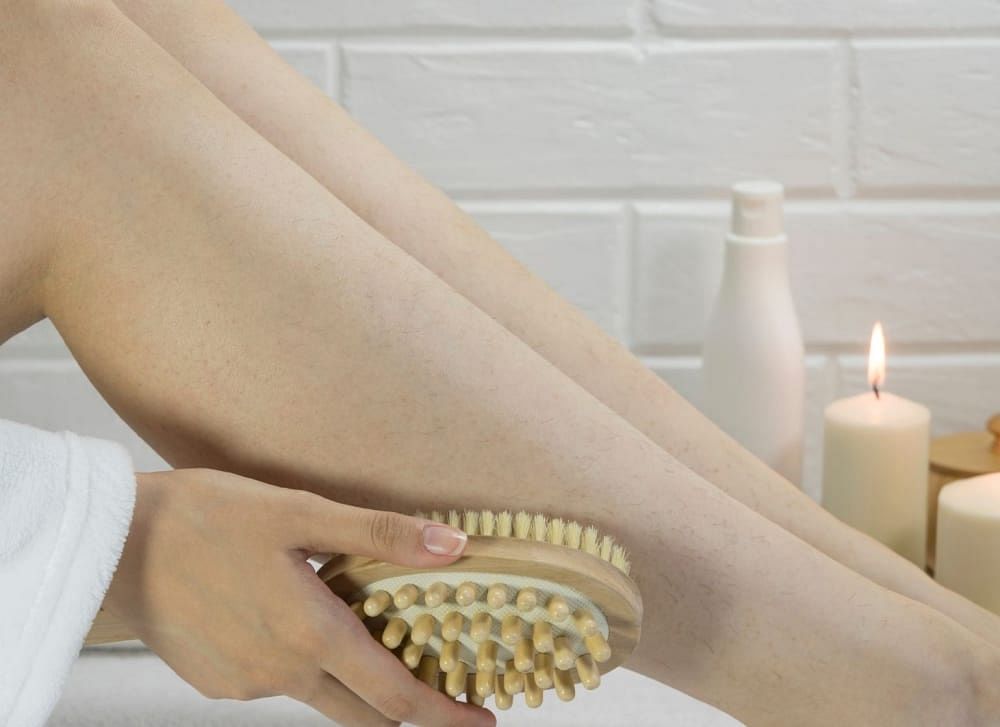Strawberry legs can't be categorized as a medical condition in itself. Instead, the appearance of black dots on legs is caused due to several external factors. Strawberry legs are mild and aren't painful or itchy.
However, the same dotted appearance accompanied with pain, rashes, and inflammation can happen due to several other skin conditions as well.
If you have been diagnosed with strawberry legs and have enlarged pores that appear like dark dots, similar to the seeds of strawberries, you must seek medical help or try some foolproof home remedies to treat the condition.
This article will help you understand more aspects related to strawberry legs.
What Are Strawberry Legs?
When we use the term Strawberry legs, we often refer to a pitted or dotted appearance of our skin on the legs, which may be attributable to various reasons. The tiny, blackish bumps, which are similar to the seeds of strawberries, are hair follicles and skin pores that are clogged with bacteria, oil, or dirt.
Fortunately, this condition isn't that harmless, and strawberry leg treatment is possible very easily by tweaking your daily shower, waxing, or shaving routine.
Strawberry Legs Causes
There are three leading causes attributable to strawberry legs:
1. Folliculitis
Folliculitis is a common skin condition that is often spotted on the legs and other body parts. Folliculitis is a skin condition that causes strawberry-like legs due to inflamed, irritated, or infected hair follicles.
In folliculitis, firstly, the hair follicles start to appear darker. When this condition worsens, the skin often gets infected, turns red, and swells up. There are various types of folliculitis:
2. Staphylococcus Aureus Folliculitis
In this type, a bacteria called staphylococcus gets trapped in the hair follicles. This leads to red, inflamed, and pus-filled bumps. This condition gets resolved on its own in some days.
3. Pseudomonas Aeruginosa Folliculitis
The pseudonymous bacteria often gets into the body through hot tubs or jacuzzis where there is the presence of stored hot water. This type of folliculitis is itchy and red. This condition also gets treated on its own.
4. Malassezia Folliculitis
This is caused due to a yeast called Malassezia. This yeast gets trapped into our hair follicles, which in turn irritates. If untreated, it worsens and turns into a painful acne-like condition.
5. Pseudofolliculitis Barbae
This type of folliculitis is razor bumps that occur from irritation and friction during shaving. This is more common in people with thick, dark, and curly hair.
6. Sycosis Barbae
The sycosis folliculitis is related to shaving as well. However, it is worse than regular razor burn because, in this condition, the hair follicles may get infected.
7. Gram-negative Folliculitis
This type of folliculitis happens as a side effect of antibiotics taken to treat acne. This is antibiotic-resistant folliculitis.
8. Ingrown Hair
When we wax or shave our legs, body hair that comes back may grow incorrectly and inwardly. If body hair gets trapped under our skin, this causes tiny bumps and inflammation. This condition may become itchy and painful. Ingrown hair is a condition that gets resolved without any specific treatment.
How do you identify that you have strawberry legs due to ingrown hair on your legs after waxing or shaving?
If you see any of the following appearances on your legs, it may be strawberry legs owing to hair ingrowth:
- Small and dark bumps called Papules
- Pus-filled blister-like bumps called Pustules
- Dark patches of skin around skin pores
- Pain or Itching
- Hair trapped under the pores of the skin
9. Acne
When we develop Acne, it extends into the sebaceous glands present around hair follicles. This increases sebum production. When sebum production increases, it leads to oil trapped or dead skin.
This allows the bacteria present on the skin to enter into the clogged pores. Blackheads or whiteheads that close the acne appear as strawberry legs.
Strawberry Legs Symptoms
There are several strawberry leg causes about which we've learned above. Now let us understand the symptoms. The most prominent sign of strawberry legs is the appearance of tiny red or black dots on our legs. At times, these bumps are raised as well. Usually, strawberry legs do not cause any itching or pain.
Having inflamed pores that are extremely itchy or painful is a red flag, and you may be experiencing another skin condition. If that's the case, visit your dermatologist, who can help you identify the leading cause of your strawberry leg-like symptoms.
Strawberry Legs Diagnosis
Hair follicles or enlarged pores that contain trapped oil, dead skin, and bacteria are the leading causes of strawberry legs. When the hair follicle or clogged skin pore is left exposed post shaving, and the air present outside comes in contact with the oil inside, it darkens the spots due to oxidation.
Strawberry legs can also resemble several skin conditions. The correct diagnosis of strawberry legs involves identifying:
- pitted or dotted appearance on the surface of the legs
- the blackening of open skin pores present on the legs
- the appearance of black or brown or bumps on legs post-shaving
If one experiences scabbing, itching, irritation, or painful inflammation, there may be a more serious underlying skin condition that only resembles strawberry leg-like symptoms. Hence accurate diagnosis is essential if you want to understand how to get rid of strawberry legs.
Strawberry Legs Treatment - How to Get Rid of Strawberry Legs
Regardless of the exact cause of strawberry legs, blackened hair follicles can get troublesome. Fortunately, it is not that complicated to treat strawberry legs and even prevent the contributing factors.
1. Treating Folliculitis
By limiting the bacteria on our skin, we can easily prevent and treat strawberry legs. This can be done by using antibacterial cleansers on our legs regularly. If the rash or irritation doesn’t clear up in a few days, it is possible that the skin is infected. In this case, you may need a doctor-prescribed antibiotic.
2. Treating Hair Ingrowth
Make sure that while shaving, you're using a proper technique. Some helpful shaving tips include:
- Pouring hot water on the legs before shaving that softens the leg hair
- Shaving in the direction of the hair growth
- Using a soap, shaving cream, or shaving gel while shaving
- Not shaving too frequently
- Leaving the skin and muscles loose while shaving
- Exfoliating the skin to remove dead skin
- Avoid tweezing the hair
- Applying moisturizer, aloe vera gel, or lotion after shaving to soothe the skin
- Avoiding any chemical-based hair removal creams or bleach
- Going for a patch test before applying any chemical-based substance on the legs
3. Treating Acne the Right Way
Acne is a skin condition that causes scarring. This is one of the most common causes of strawberry legs. Acne that occurs after shaving or hair removal due to hair ingrowth or other reasons can leave the pores darkened and scarred. Treating acne the right way is very important.
One can treat such acne using over-the-counter (OTC) creams, antiseptic ointments, or cleansers. If these don’t seem to work, one can also consult their doctor and go for prescription skincare.
Active ingredients like tretinoin, benzoyl peroxide, or adapalene are beneficial. If you have chronic acne, you may need to go for electrolysis or laser therapy or even a chemical peel. For infected acne, you must use an antibiotic first and then treat the scars.
Strawberry Legs Home Remedies
Some effective strawberry legs home remedies for the treatment and prevention are as follows:
- Shaving carefully and correctly carefully along with a lotion or moisturizing cream
- Choosing an epilator over shaving
- Moisturizing the skin daily and thoroughly using good quality hydrants
- Exfoliating the skin using homemade or natural scrubs at regular intervals
- Opting for an OTC (over-the-counter) product that consists of glycolic acid or salicylic acid
Strawberry Legs Prevention
Using an epilator can get painful or uncomfortable, similar to waxing. However, enduring this one-time pain can help you prevent strawberry legs. Shaving may seem more convenient and quick, but in the longer run, it can increase the risk of strawberry legs.
Skipping shaving foam or cream while hair removal at home can also cause strawberry leg symptoms. Hence, it's always better to moisturize the area well before shaving and use shaving foam before using a razor.
Talking about razors, experts recommend using fresh and disposable razors that have sharp and flexible blades. Try out razors that have flexible blades that can contour around the curves of the legs. Razors with pivoting heads are also helpful.
If the blade of your razor is too broad and isn't flexible, it might increase the pressure applied on the skin and cause cuts or nicks. Therefore opting for narrower blades is better.
Summing Up on Strawberry Legs
For most people, the strawberry leg is a condition that can easily be managed. These remedies and prevention measures prove to be very effective in eliminating strawberry legs at home.
However, it may be tougher to deal with and treat strawberry legs for people with dark skin pigmentation, thick body hair, or problematic hair follicle challenges. In most cases, strawberry legs don't cause pain, itchiness, or inflammation. If these three symptoms occur, it may be a wise decision to consult your skin doctor.
FAQs
1) How Effective Is Laser Therapy for Strawberry Legs?
Laser therapy is one of the best and the most convenient ways to treat and eliminate the condition of strawberry legs from the roots. Laser is a long-term professional therapy for hair removal, especially beneficial for those with coarse or thick hair.
2) Do Strawberry Legs Go Away on Their Own?
Strawberry legs treatment at home is very much possible. Mostly, strawberry legs get resolved on their own by making only a slight change in shaving or waxing regime. However, people with thicker body hair, skin pigmentation, darker skin, or those with more complicated hair follicle problems may have a more challenging time in treating strawberry legs.
3) How Long Does It Take for Strawberry Legs to Heal?
According to dermatologists, it takes approximately 2-6 weeks for any treatment of strawberry legs to show results. It takes the same duration for home remedies to treat strawberry legs.
4) Can Waxing Help Strawberry Legs?
If shaving your legs is the main culprit of your strawberry legs, you can try epilating or waxing. This can pull out the hair roots and treat the problem of ingrown hair. Waxing is also suitable for scraping off dead skin. It's better than shaving because it doesn't cause razor bumps, nicks, or cuts.











